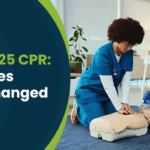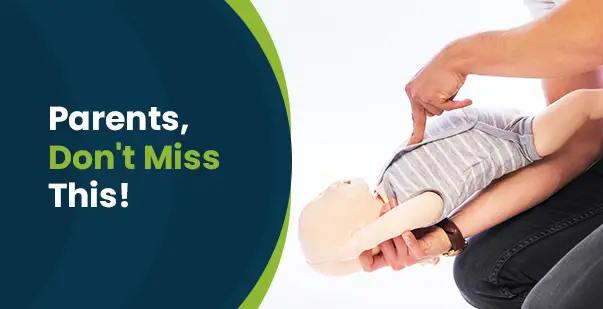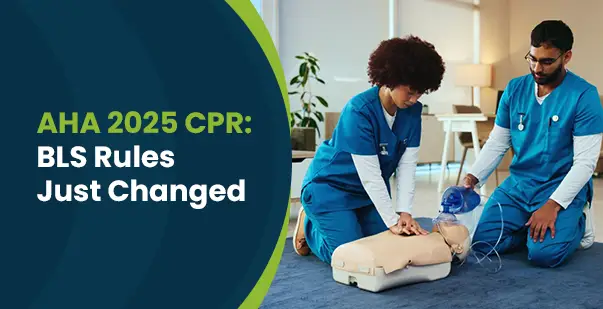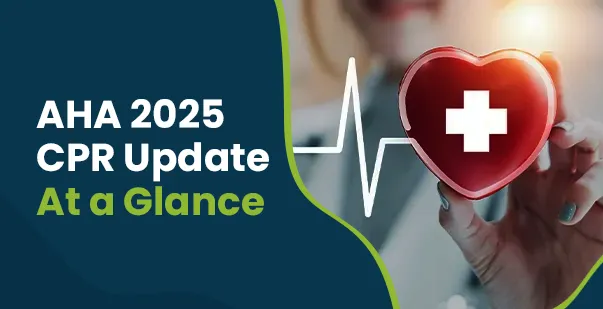Infant CPR (cardiopulmonary resuscitation) can save a baby’s life when the infant stops breathing or becomes unresponsive. In January, a police officer in Middle Township, New Jersey, acted quickly after finding a mother performing CPR on her 1-week-old baby. The infant was turning blue and unresponsive. The officer immediately took over, giving chest compressions, and within moments, the baby began to regain consciousness. Stories like this remind us that knowing CPR isn’t just for professionals. It could be the skill that helps you save someone you love. In fact, CPR can double or triple survival rates compared to no CPR. Stories like this show how knowing infant CPR can change an outcome in just minutes.
This guide will walk you through the signs a baby needs CPR, what to do if the baby is choking, and when to stop CPR.
How to Recognize When an Infant Needs CPR?
Infant CPR is a life-saving method that uses gentle chest compressions and breaths to help a baby’s heart and lungs start working again. You should begin infant CPR if the baby is unresponsive and not breathing normally. In practice, that means the infant does not wake up to your voice or touch, or has blue-ish skin color (cyanosis), weak or silent coughing, or high-pitched wheezing sounds. In choking cases, the infant may be unable to cry. Many caregivers mistake silent coughing or wheezing for normal baby noises. A normal baby sounds soft and rhythmic, whereas a distress baby sounds strangled, strained, or faint and may come with visible effort to breathe..
Here’s how you can further check for key signs and take immediate steps:
- Check Responsiveness: Gently tap the infant’s foot or shoulders and shout, “Baby, can you hear me?” (Do not shake the baby.) If there is no response within 5–10 seconds, move to the next step.
- Check Breathing: Check if the baby is breathing normally- see if the chest is rising with breaths. If the baby is not breathing or only gasping (a sign of agonal breathing), that indicates CPR is needed.
- Call for Help: If CPR is needed, shout for help. Have someone call 911 immediately and bring an AED (automatic external defibrillator) if available. If you are alone, begin baby CPR right away and call 911 after about 2 minutes of CPR (or as soon as you have done five cycles of compressions and breaths).
Now that we know how to understand the signs of a distressed baby, let us see how to do CPR on a baby.
How Do You Perform CPR on an Infant?
A study in Resuscitation Plus shows that while return of spontaneous circulation (ROSC) happens in 10%–72% of pediatric cardiac arrest cases, only 16%–39% survive to hospital discharge. But the best thing is that you can make a difference. The right CPR, done at the right time, can turn the odds around. Here’s exactly how to do CPR on an infant:
Step 1. Ensure Safety
Quickly check that the area is safe for you and the infant. Put on disposable gloves or a face shield if you have them (to protect against germs).
Step 2. Call for Help
If someone is with you, tell them to call 911 (or your local emergency number) and get an AED if one is nearby. If you are alone, you may need to start CPR first and call right after a minute or two. Research shows that bystander CPR can significantly improve outcomes; survival at hospital discharge is about 7.0% with dispatcher-assisted CPR.
Step 3. Begin Chest Compressions
Place the infant flat on his back on a firm surface (like the floor or a table). Using the correct technique, start giving chest compressions at a steady rate (100–120 compressions per minute is ideal). Compress the chest deeply, about 1.5 inches (4 cm), which is roughly one-third of the infant’s chest depth. Pressing much deeper can cause injury to the ribs or chest, so use firm but gentle pressure. After each compression, allow the chest to fully come back up (let the chest recoil) before pushing down again. Count quickly, “1,2,3,…” up to 30. Counting out loud during CPR helps you keep a steady rhythm, stay focused, and ensure you give the correct number of compressions.
Step 4. Open the Airway and Give Breaths
After 30 compressions, open the airway by tilting the head slightly back and lifting the chin. Pinch the baby’s nose shut and make a seal over the baby’s mouth with your mouth. Or better, cover both the baby’s nose and mouth with your mouth (since infants are small). Give 2 gentle breaths, each over about 1 second, just enough to make the chest visibly rise. If the chest doesn’t rise, reposition the head and try the second breath again.
Step 5. Repeat Cycles of CPR
Continue repeating cycles of 30 compressions with interruptions of 2 breaths (if alone) until the baby is responding (moving, breathing), or an AED becomes available on the scene, or advanced assistance takes over. Never discontinue CPR until assistance is on the scene or the baby is alert. If you become exhausted, switch with another trained individual if available.
Step 6. Use an AED if Available
If a manual defibrillator is available, it is the preferred option for infants. If not, use an AED with pediatric pads or in a pediatric setting. When these are not available, a standard AED may be used. For very small infants, place the pads in an anterior–posterior position (one on the chest and one on the back) to ensure they do not touch each other. Continue CPR until the AED or defibrillator is ready to analyze and follow its prompts. Studies show that rapid bystander CPR combined with AED use can improve survival up to fourfold compared to no intervention.
Read More: How Advanced CPR Training Tools Are Changing Education in 2025
Can You Use 15 or 30 Compressions During Infant CPR?
Currently, experts advise of 30:2 ratio for a single rescuer and a 15:2 ratio for two rescuers. Here are the details:
| Scenario | Compression-to-Breath Ratio | Why It Differs |
| Single Rescuer | 30:2 | When alone, you give more compressions before pausing for breaths to keep blood flowing steadily. Switching roles takes time, so this ratio maintains circulation. |
| Two Rescuers | 15:2 | With two people, one performs compressions while the other gives breaths. This allows more frequent oxygen delivery, which is important because babies need oxygen more often than adults. |
- Compression Depth: 1½ inches (4 cm) — about one-third of the chest
- Rate: 100–120 per minute (beat of “Stayin’ Alive”)
Remember: If you’re alone, start CPR immediately and give 2 minutes of care before calling emergency services if no one else is available to help.
How Do You Perform Infant CPR if the Baby Is Choking?
Choking is a common cause of infant respiratory arrest. It ranked 4th among unintentional deaths in all age groups, with about 5,529 choking fatalities in 2023. If an infant is conscious and choking (gasping, cannot cry or cough effectively, and turning blue), do this first:
- Back Blows
Lay the baby face down along your forearm, supporting the head. With the baby’s head lower than the body, give up to 5 quick back blows between the shoulder blades with the heel of your hand.
- Chest Thrusts
If back blows don’t clear the obstruction, turn the baby face-up on your forearm, keeping the head and neck fully supported and lower than the chest.
- Use two fingers to deliver up to 5 quick chest thrusts in the middle of the breastbone.
- Each thrust should be firm but controlled, pressing about one-third to one-half the depth of the chest.
- Only perform chest thrusts when back blows fail to remove the object.
- Repeat Chest Thrusts and Back Blows
Repeat sets of five back blows and five chest thrusts until the object has been removed, or the infant can breathe or cry. For an unconscious infant, begin the CPR immediately, clearing the mouth of visible objects before administering rescue breaths. Do not perform blind finger sweeps, as this can push the object deeper into the airway.
When Should CPR in an Infant Be Stopped?
In some cases, the continued CPR is the best choice, but in other cases, it’s safe or even better to discontinue. Here are the common scenarios when you should stop giving infant CPR:
- Signs of Life
If the baby begins to breathe, is active, or is crying, stop CPR. Continue to monitor for breathing and have the airway open until help arrives. Put the baby on their side (recovery position) if breathing normally but still unconscious.
- EMS/AED Takeover
You can stop CPR when trained emergency responders arrive and take over care. Professionals have advanced equipment and techniques that can provide more effective treatment. Until then, keep giving compressions and rescue breaths to give the infant the best possible chance of survival.
- Unsafe Scene
If your safety is at risk, for example, due to fire, structural damage, or other hazards, it is acceptable to stop CPR. Move yourself and the infant to a safer location before attempting to continue care, but never put your own life in danger.
- Rescuer is Exhausted
CPR is physically demanding. If you become so tired that you can no longer give effective compressions and no one else is available to help, you can stop. However, try to keep going as long as you can, as every extra minute of CPR matters.
Keep in mind that continued CPR for infants gives the best chance of survival. Indeed, pediatric survival after cardiac arrest has improved dramatically in recent decades. One Swedish registry study found that 30-day survival for infants suffering out-of-hospital arrest increased from just 2% in the early 1990s to 19% by 2020.
Read More: How Artificial Intelligence is Revolutionizing CPR and First Aid
What Common Mistakes Should You Avoid During Infant CPR?
Even small mistakes during infant CPR can make it less effective or even cause harm. Knowing what to avoid helps you give the best possible care in an emergency. The most frequent mistakes people make are:
- Applying Too Much or Too Little Pressure
An error frequently committed is pushing too aggressively, which is detrimental, or pushing too softly, which will not provide a sufficient amount of blood being circulated. Push strongly but not aggressively, to 1.5 inches. Always permit the chest to fully rise before the next compression.
- Incorrect positioning of hands or fingers
Placing your fingers too high, too low, or on the ribs will hurt the baby and lower the success of compressions. Always place two fingers in the center of the chest, below the nipple line, and never place your fingers on the ribs or the stomach.
- Providing Breaths Too Forcefully
Blowing too fast or too hard is harmful to the baby’s lungs. Use instead slow, gentle puffs of air, just sufficient to see the chest rise. Put your mouth on the baby’s nose and mouth to get a good seal before giving breaths.
Key Takeaways on Infant CPR
Infant CPR is more than just a safety skill. Knowing how to respond when a baby is unresponsive and not breathing gives you the power to keep blood and oxygen flowing until professional help arrives. This training teaches you how to recognize the warning signs, use the correct chest compression technique, give gentle rescue breaths, and handle emergencies like choking with confidence.
The right knowledge and quick action can protect a child’s life and prevent long-term harm. Don’t wait until an emergency happens to wish you had learned these steps. Take the next step, enroll in a certified CPR course today. Your skills could be the reason a baby survives tomorrow.









